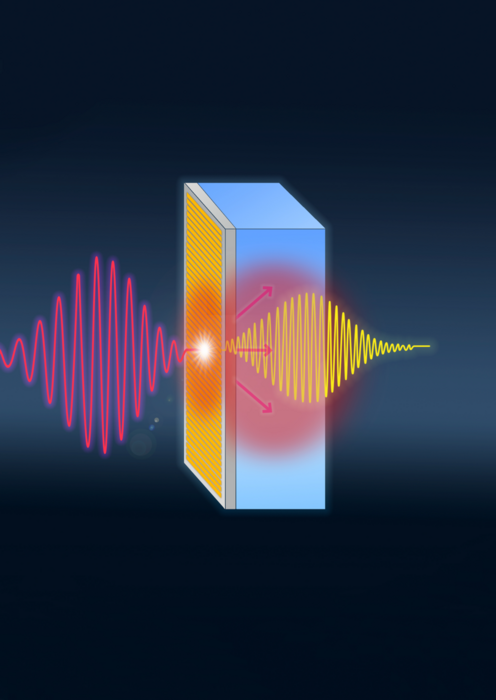Terahertz light is the radiation emanating from the far-infrared region of the emission spectrum. It is presently not completely exploited in technology, although it demonstrates considerable potential for numerous applications in homeland security screening, sensing, and future (sixth generation) mobile platforms.

Incident terahertz radiation (left) that is incident on a topological insulator metamaterial is efficiently upconverted to its third harmonic, thanks to strong nonlinearity and efficient electronic surface-to-bulk heat dissipation. Image Credit: K. J. Tielrooij.
This radiation is not harmful because of its small photon energy, but it can enter a number of materials, such as packaging, skin, etc.
In the last several years, many research groups have concentrated their attention on finding methods and materials to efficiently produce THz electromagnetic waves. Among them is the amazing material graphene, however the generated terahertz output power is minimal.
Better performance has been accomplished with topological insulators (TIs)—quantum materials that act as insulators in the bulk while displaying conductive features on the surface. Details of this accomplishment are reported in the journal Light: Science & Applications.
This study was conducted by members of the ICN2 Ultrafast Dynamics in Nanoscale Systems Group, directed by Dr. Klaas-Jan Tielrooij, and by the High-field THz Driven Phenomena Group at the Helmholtz-Zentrum Dresden-Rossendorf (HZDR, Germany), directed by Dr. Sergey Kovalev, in partnership with scientists from the ICN2 Physics and Engineering of Nanodevices Group, headed by ICREA Prof. Sergio O. Valenzuela, from the School of Physics and Astronomy of the University of Manchester (UK), and the Physics Institute of the University of Würzburg (Germany).
The experiments were carried out at the TELBE THz facility in Dresden.
Previous studies have demonstrated that materials that host electrons with zero effective mass allow efficient production of terahertz harmonics, including the above-mentioned graphene and topological insulators.
The phenomenon of harmonic generation takes place when photons of the same energy and frequency interact non-linearly with matter resulting in the release of photons where the energy is a multiple of that of the incident ones. This can be manipulated, for instance, to upconvert electronically produced signals in the high GHz regime into signals in the THz regime.
Dr. Tielrooij and coworkers explored the performance of two topological insulators—the prototypical Bi2Se3 and Bi2Te3—in direct comparison with a graphene sample under study. They detected that, while the highest power of the harmonics produced in graphene is restricted by saturation effects (which occur at high incident powers) in these quantum materials, it continued to grow with the incident fundamental power.
The outcomes of the experiments showed an improvement in produced output power by orders of magnitude over graphene, reaching the milliwatt regime.
This substantial divergence in behavior is because of the fact that topological insulators can depend on an extremely efficient cooling mechanism in which the massless charges on the surface dispel their electronic heat to those in the rest of the thin film.
Simply put, bulk electrons assist the surface-state electrons by sinking electronic heat. The maximum output power for the terahertz third-harmonic—i.e., radiation with three times the same energy—was accomplished in a metamaterial that comprised a topological insulator film along with a metallic grating—containing metal strips divided by gaps on the material’s surface.
In this work, we were able to demonstrate that the saturation effect occurring in graphene is much less present in topological insulators. This occurs thanks to a novel cooling mechanism between surface and bulk electrons of topological insulators.
Dr Klaas-Jan Tielrooij, Study First Author, ICN2 Ultrafast Dynamics, Nanoscale Systems Group, University of Barcelona
Sergey Kovalev, the study’s last author, adds: “These quantum metamaterials thus bring nonlinear terahertz photonics technology a big step closer. The obtained results furthermore offer interesting possibilities towards studying the quantum properties of these materials with prospects towards quantum technologies.”
Journal Reference
Tielrooij, K-J., et al. (2022) Milliwatt terahertz harmonic generation from topological insulator metamaterials. Light Science & Applications. doi.org/10.1038/s41377-022-01008-y.